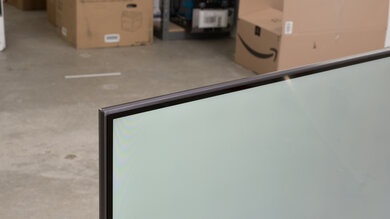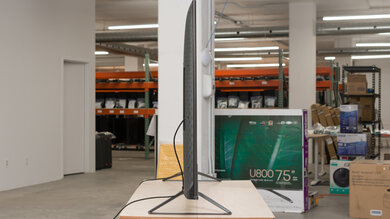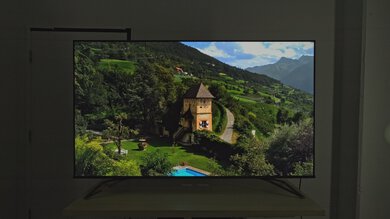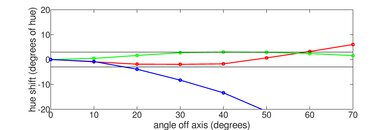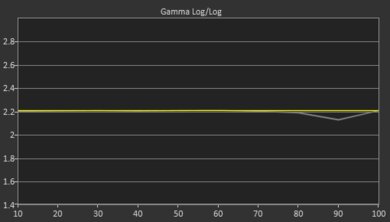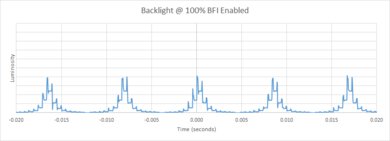The Hisense U800GR 8k is Hisense's first 8k LED TV available in the United States. It comes with the Roku TV platform as its smart interface, which is user-friendly. It's only available in a 75 inch size, and its VA panel displays deep blacks, but like some other 8k TVs, its native contrast ratio isn't as good as 4k TVs with VA panels. It has a local dimming feature that helps further deepen any blacks, but it also causes blooming around bright objects. There are a few gaming features like its HDMI 2.1 bandwidth, variable refresh rate (VRR) support, and quick response time, but while it has low input lag with 4k games, it increases with 8k games. Also, it supports HDR10+ and Dolby Vision for HDR content, and it displays a wide color gamut, but its HDR peak brightness is just okay. Although the 8k resolution is meant to deliver crispier images compared to 4k TVs, there's also dithering with 4k and 8k signals, so it doesn't display these resolutions perfectly.
Our Verdict
The Hisense U800GR is very good for most uses. It's a great choice for watching movies in dark rooms because its VA panel has a high contrast, and the local dimming helps it display deep blacks, but there's blooming around bright objects. It's also good for watching movies in HDR because it displays a wide color gamut, but its HDR peak brightness is just okay. It's good for watching shows or sports in bright rooms, thanks to its high SDR peak brightness and excellent reflection handling, but it has narrow viewing angles, and it doesn't properly upscale 480p signals. Lastly, gamers should enjoy its HDMI 2.1 bandwidth, VRR support, and low input lag, but its input lag increases with 8k signals.
-
VA panel with high contrast ratio.
-
Local dimming helps it display deep blacks.
-
Excellent reflection handling.
-
Easy-to-use Roku TV.
-
Blooming around bright objects.
-
Dithering with 1080p, 4k, and 8k signals.
-
Narrow viewing angles.
The Hisense U800GR is great for watching movies in dark rooms. It displays deep blacks, thanks to its great contrast ratio and decent local dimming feature, but there's blooming around bright objects that could become distracting. It removes 24p judder from any source, which is great for watching movies. It upscales 1080p, 4k, and 8k content well, but there's some dithering, and it has trouble displaying 480p content, so it's not a good choice for watching DVDs.
-
VA panel with high contrast ratio.
-
Local dimming helps it display deep blacks.
-
Removes 24p judder from any source.
-
Easy-to-use Roku TV.
-
Blooming around bright objects.
-
Doesn't properly upscale 480p content.
-
Dithering with 1080p, 4k, and 8k signals.
The Hisense U800GR is good for watching TV shows in bright rooms. It has good peak brightness and excellent reflection handling, meaning visibility won't be an issue. It doesn't have any trouble upscaling 720p content from HD cable channels, but sadly, it has issues properly upscaling 480p content, like from SD channels. It also has narrow viewing angles, and the image looks washed out from the sides.
-
Excellent reflection handling.
-
Good SDR peak brightness.
-
No issues upscaling 720p content.
-
Easy-to-use Roku TV.
-
Doesn't properly upscale 480p content.
-
Narrow viewing angles.
-
Some uniformity issues.
The Hisense U800GR is very good for watching sports. Most fast-moving objects look smooth, thanks to the quick response time. It also performs well in bright environments because it has excellent reflection handling and good enough brightness to fight glare. It doesn't have issues upscaling 720p content from cable channels, but it has trouble with 480p signals from SD channels. It also has narrow viewing angles, meaning it's not a good choice for wide seating arrangements.
-
Excellent reflection handling.
-
Good SDR peak brightness.
-
No issues upscaling 720p content.
-
Quick response time.
-
Narrow viewing angles.
-
Some uniformity issues.
The Hisense U800GR is impressive for playing video games. It has HDMI 2.1 bandwidth that allows you to play high-frame-rate and high-resolution games, and it has FreeSync support to reduce screen tearing. Motion looks smooth thanks to its quick response time, and it has low input lag with most signals, except for 8k. It's also a good choice for dark room gaming due to its high contrast, but the local dimming feature causes blooming around bright objects.
-
VA panel with high contrast ratio.
-
Quick response time.
-
HDMI 2.1 bandwidth.
-
FreeSync VRR support.
-
Dithering with 1080p, 4k, and 8k signals.
-
Input lag increases with 8k signals.
The Hisense U800GR is very good for watching HDR movies. It performs well in dark rooms as it has a great native contrast for deep blacks, and the local dimming feature is decent, but it also causes blooming. It supports both HDR10+ and Dolby Vision content, and it displays a wide color gamut for HDR content. It has okay HDR brightness, so some highlights pop, but it doesn't get bright enough for a satisfying HDR experience.
-
VA panel with high contrast ratio.
-
Local dimming helps it display deep blacks.
-
Supports both HDR10+ and Dolby Vision.
-
Blooming around bright objects.
-
Dithering with 1080p, 4k, and 8k signals.
-
HDR brightness is just okay.
The Hisense U800GR is impressive for HDR gaming. It has many gaming features like HDMI 2.1 bandwidth for high-frame-rate gaming, VRR support, and a 120Hz panel. It also has low input lag with 4k signals, and the response time is good. HDR content looks very good thanks to its high contrast and wide color gamut, but there's blooming around bright objects, and its HDR brightness with most content isn't the brightest.
-
VA panel with high contrast ratio.
-
Local dimming helps it display deep blacks.
-
Quick response time.
-
HDMI 2.1 bandwidth.
-
FreeSync VRR support.
-
Blooming around bright objects.
-
Dithering with 1080p, 4k, and 8k signals.
-
Input lag increases with 8k signals.
-
HDR brightness is just okay.
The Hisense U800GR is great to use as a PC monitor. It has low input lag with 4k signals for a responsive desktop experience, but since it increases with 8k signals, you'll have to drop the resolution to maintain a low input lag. It has HDMI 2.1 bandwidth, and it displays clear text with most resolutions. Sadly, it has narrow viewing angles meaning the edges appear washed out if you sit too close, and our unit has some uniformity issues.
-
Excellent reflection handling.
-
Good SDR peak brightness.
-
HDMI 2.1 bandwidth.
-
Displays clear text with most resolutions.
-
Dithering with 1080p, 4k, and 8k signals.
-
Some uniformity issues.
-
Input lag increases with 8k signals.
- 8.0 Mixed Usage
- 8.0 Movies
- 7.8 TV Shows
- 7.9 Sports
- 8.4 Video Games
- 7.9 HDR Movies
- 8.4 HDR Gaming
- 8.3 PC Monitor
Changelog
- Updated Jul 08, 2025: We uploaded the latest brightness measurements and uniformity photos for the Accelerated Longevity Test.
- Updated Apr 17, 2025: We uploaded the latest brightness measurements and uniformity photos for the Accelerated Longevity Test.
- Updated Feb 11, 2025: We uploaded the latest brightness measurements and uniformity photos for the Accelerated Longevity Test.
- Updated Nov 20, 2024: We uploaded the latest brightness measurements and uniformity photos for the Accelerated Longevity Test.
- Updated Sep 11, 2024: We uploaded the latest brightness measurements and uniformity photos for the Accelerated Longevity Test.
Check Price
Differences Between Sizes And Variants
The Hisense U800GR is Hisense's only 8k LED TV, and it's only available in a 75 inch size. This model is sold in the United States, and there's a similar model available in Australia, known as the Hisense U80G, but that has Android TV and not Roku TV. Because Hisense releases different models outside North America, our review isn't valid for any similar model.
If someone comes across a different type of panel or if their Hisense U800GR doesn't correspond to our review, let us know, and we'll update the review. Note that some tests, like gray uniformity, may vary between units.
Our unit was manufactured in June 2021; you can see the label here.
Popular TVs Comparisons
The Hisense 75U800GR is a great 8k TV that provides more gaming features than LG QNED99 8k or the LG NANO99 8k 2021, and its VA panel has a great contrast ratio. Its picture quality is very good, but considering it has dithering issues while displaying 4k and 8k content, and it doesn't properly upscale 480p content, it's worth getting a 4k TV like the Hisense U8G instead.
Also see our recommendations for the best LED TVs, the best Roku TVs, and the best 70-75-77 inch TVs.
The LG NANO99 8k 2021 and the Hisense U800GR 8k are different types of 8k TVs. The LG has an IPS panel with wide viewing angles, and it's available from 65 to 86 inches, while the Hisense is only available in a 75 inch size and has a VA panel with better contrast. The LG does a better job at upscaling lower-resolution content, and it doesn't have any dithering issues like the Hisense. The Hisense is better in dark rooms as it has a better local dimming feature, and it has more gaming features like VRR support.
The Hisense U8G and the Hisense U800GR 8k are LED TVs with different features. The U8G is a 4k TV available in 55 and 65 inch sizes and has Android TV, while the U800GR is an 8k TV available in a 75 inch size and uses Roku TV. Despite the higher resolution on the U800GR, the U8G performs better in a few areas like its higher peak brightness, better contrast, improved local dimming, and it displays 480p and 4k content better. They have similar gaming features, but the U800GR has a slightly quicker response time.
The TCL 6 Series/R648 2021 8k QLED and the Hisense U800GR 8k are similar 8k TVs with Roku TV. The TCL uses Mini LED backlighting that lets it get much brighter, especially in HDR, and it also has a higher contrast ratio. They have similar gaming features, but the Hisense has a slightly quicker response time. The Hisense is only available in a 75 inch size, while the TCL is available in 65 and 75 inches, but other than that, the differences are minimal.
The LG QNED99 8k and the Hisense U800GR 8k are both very good 8k TVs with different features. The LG has an IPS panel with wider viewing angles, and despite having a lower contrast than the VA panel on the Hisense, it has Mini LED backlighting that allows it to have decent local dimming. Also, the LG gets brighter, especially in HDR. Still, the Hisense is better for use in dark rooms because it has better black uniformity. The Hisense is better for gaming because it has a quicker response time, and it has VRR support, which the LG doesn't have.
The LG C1 OLED and the Hisense U800GR 8k are two different types of TVs. The LG is a 4k TV with an OLED panel, resulting in a near-infinite contrast ratio, perfect black uniformity, and wide viewing angles. It also has a quicker response time and lower input lag than the Hisense. On the other hand, the Hisense is an 8k TV with an LED panel that gets brighter in SDR, and it doesn't suffer from the permanent burn-in risk that OLEDs have. Also, the Hisense is only available in a 75 inch size, while the LG is available in a wide range of sizes.
Video
Test Results
The Hisense U800GR looks much like the Hisense U8G as it has the same textured plastic back, and the feet are similar. It has a stylish overall design, and it should look nice in most home theater setups.
The back of the Hisense U800GR has a textured back panel, and there speakers at the bottom and vents at the top. It also has two clips for cable management to keep your setup tidy.
The Hisense U800GR is thin and doesn't stick out much when wall-mounted. The cable management clips stick out at the bottom, and they seem like they aren't meant to be removed, but the thickness of the TV without them is 2.95" (7.5 cm).
The Hisense U800GR's build quality is good. It's mainly made of plastic, and it feels well-put-together throughout, with no glaring issues. The metal feet feel solid, but there's still wobble from front to back. Sadly, the plastic on the back panel feels cheap and flexes easily, but this isn't an issue once you place the TV on its stand or mount it.
The Hisense U800GR has a great contrast ratio thanks to its VA panel. It displays deep blacks with the local dimming feature enabled, but its native contrast isn't as good as other 4k TVs with VA panels, like the Hisense U8G. However, it's still better than Samsung's 8k TVs like the Samsung QN800A 8k QLED. Keep in mind that contrast may vary between units.
The Hisense U800GR has good SDR peak brightness. It gets bright with small highlights, but it quickly loses its brightness with larger areas due to its Automatic Brightness Limiter, and its real scene peak brightness is only decent. Still, you shouldn't have many issues using it in a well-lit room.
We tested the brightness after calibration in the 'Movie' Picture Mode with the TV Brightness set to 'Brighter', Local Dimming on 'High', Color Temperature set to 'Warm', the Backlight at '100', and the Contrast at '90'. We couldn't get a brighter image with any other setting.
The Hisense U800GR's local dimming feature is decent. It has 180 zones, and overall, it's a decent implementation of local dimming, but it has some drawbacks. It doesn't crush blacks at all, meaning you won't lose details in scenes with small highlights like a star field, and objects transition between the zones well with real content. Sadly, there's noticeable blooming with any bright object on a dark background, especially with subtitles, and these are distracting even with real content. The blooming is the biggest downside of the local dimming, and while the TV looks decent from in front, the blooming becomes more noticeable as you move off-center.
Note: You can see in the real content video, particularly in the last scene with the people jumping, that there are two dead pixels in the center. We refreshed the TV, and they were still there, but they're not always visible, and this varies between units as not all units will have dead pixels.
The local dimming feature in Game Mode looks exactly like outside of it. There aren't noticeable differences.
The Hisense U800GR has alright HDR brightness. It gets brightest with small highlights, which is great as they pop, but the overall real scene brightness won't be enough to deliver a satisfying HDR experience. The EOTF is brighter than the target PQ curve, so most scenes are brighter than they should be until there's a sharp roll-off at its max brightness, causing a loss of details in bright highlights.
We tested it in the 'Dark HDR' Picture Mode with TV Brightness on 'Brighter', Local Dimming on 'High', Color Temperature set to 'Warm', and with Backlight and Contrast both at '100'. We got the brightest results with these settings, and if you find the screen is too dim, then set the Color Temperature to 'Normal'. This doesn't change the peak brightness, but it makes the image appear slightly brighter as you can see in this EOTF.
The Hisense U800's HDR brightness in Game Mode looks the same as outside of it, and there's no noticeable difference. Any difference in the individual results comes down to margin of error. We tested it using the same settings outside of Game Mode, but with the Game Mode setting enabled.
The Hisense U800GR has decent gray uniformity. The edges of the screen are noticeably darker, and there's some dirty screen effect in the center, which could get distracting during sports. Uniformity is better in near-dark scenes, but there's a bit of backlight bleed. You can't see the two dead pixels explained in the Local Dimming section because they're not always visible. Keep in mind that uniformity may vary between units.
The Hisense U800GR has excellent black uniformity. Without local dimming, the screen looks a bit blue, and there's backlight bleed. The local dimming feature improves the contrast, but there's a lot more blooming around the center cross. Note that uniformity may vary from unit to unit.
The Hisense 75U800GR has excellent reflection handling. The semi-gloss finish diffuses light well, so even reflections from strong light sources aren't distracting. Combined with its good peak brightness, it performs well in bright rooms.
The Hisense U800GR has good out-of-the-box accuracy. Most colors are fairly accurate, and the color temperature is close to the 6500K target. However, the white balance is slightly off, and the gamma doesn't follow the 2.2 target well as most scenes are too dark, and bright scenes are over-brightened. Keep in mind that accuracy may vary between units.
The Hisense U800GR has fantastic accuracy after calibration. Any remaining white balance and color inaccuracies are hard to spot, except saturated blues are slightly inaccurate. The color temperature is even closer to the target, and the gamma is also improved.
See our recommended settings here. All calibration is done through the Roku app and not directly on the TV.
Unfortunately, the Hisense U800GR doesn't properly upscale 480p content, so it's not a good choice for watching DVDs. The aspect ratio is off, and the image is stretched out. We tried playing with a few settings, but nothing fixed it, and we noticed the same thing with the Hisense U6GR.
Like with 1080p and 4k content, there's some dithering that you can see if you look closely in the shadows, but other than that, the Hisense U800GR displays native 8k content well. We took a pixel photo so you can see how each pixel is separate from each other. We use this to test for contrast modulation, which is a measurement to see it's a true 8k TV with pixels separate from the next.
The Hisense U800GR has a BGR subpixel layout, which doesn't affect picture quality but can affect how text is displayed when using the TV as a PC monitor. You can read about it here. You can also see the pixel dithering in the blue pixels.
The Hisense 75U800GR has good color volume. Thanks to its fantastic DCI P3 color space coverage, great contrast, and high peak brightness, it displays colors at a wide range of luminance levels in that color space. It's still okay with Rec. 2020, but it doesn't display as many colors.
The Hisense U800GR has amazing gradient handling. There's minimal banding throughout, with only a bit of banding in the dark grays and greens. There's a setting to reduce banding, but it doesn't seem to do much with our test pattern or with real content.
The Hisense U800GR doesn't have any signs of temporary image retention after displaying a high-contrast static image, but this may vary between units.
We don't expect VA panels to experience permanent image retention, as the VA panel in our long-term test appears immune.
The Hisense U800GR has an excellent response time. Motion looks smooth for the most part, but there's some image duplication due to the backlight flicker. The response time in dark transitions is slow, which is typical of VA panels, and leads to some black smearing.
The Hisense U800GR has an optional backlight strobing feature, commonly known as black frame insertion. It only flickers at 120Hz, and it creates image duplication with 60Hz content, as you can see in the photo. Note that the BFI scoring is based on the flicker frequencies at which it works and not the actual performance.
There's a motion interpolation feature to interpolate 30 and 60 fps content up to 120 fps. Like most other TVs, it works well with slow-paced scenes, and there aren't any visible issues. However, there are more artifacts with fast-moving objects in action-packed scenes, which could get distracting.
Due to the quick response time, low-frame-rate content appears to stutter because each frame is held on longer. If that bothers you, try enabling the motion interpolation feature.
The Hisense U800GR can remove 24p judder from any source, including native apps and 60p/i sources, and you don't need to adjust any setting. This helps with the appearance of motion in movies.
The Hisense U800GR has variable refresh rate support in the form of native FreeSync. We didn't experience any issues with our AMD RX 6600 graphics card and the Xbox Series X with 1080p and 4k signals, but there was tearing in the pendulum demo with 1440p signals on the RX 6600. However, 1440p VRR doesn't tear in games on the Xbox Series X, meaning the TV supports it, but because our regular pendulum demo tears, we're leaving 1440p VRR as Unknown. Although the NVIDIA Control Panel with our RTX 3070 showed that it supports G-SYNC, there's constant tearing.
The Hisense U800GR has low input lag with most resolutions. Gaming feels responsive with 1080p, 1440p, and 4k signals thanks to its low input lag, but it increases a lot with 8k @ 60Hz signals, so it may not be ideal for some people playing reaction-based games. We remeasured the 8k @ 60Hz input lag a few times and kept getting the same results, consistent with the LG NANO99 8k 2021 and the LG QNED99 8k. Also, we couldn't get proper VRR input lag readings, which we experienced with the TCL 6 Series/R648 2021 8k QLED. We're looking into this issue, and we'll update the review once we fix it.
The Hisense U800GR displays most common resolutions up to 8k @ 60Hz. It also displays proper chroma 4:4:4 with any signal except for 1440p, as text looks fuzzy with 1440p @ 60Hz and 1440p @ 120Hz signals.
The Hisense U800GR supports any common format from the Xbox Series X and PS5, and Dolby Vision works up to 4k @ 60Hz on the Xbox Series X. It has support for Auto Low Latency Mode that automatically switches the TV into Game Mode when you launch a game from a compatible device.
HDMI ports 1 and 2 support the full 48 Gbps bandwidth of HDMI 2.1, which you can see here, and HDMI 3 and 4 support HDMI 2.0 bandwidth. The Hisense 75U800GR isn't advertised to support ATSC 3.0.
The Hisense U800GR has eARC support, which allows you to pass Dolby Atmos and DTS:X signals to a compatible receiver through an HDMI connection. Unlike the Hisense U9DG, its eARC port isn't one of the HDMI 2.1 ports, so you can connect a receiver and still use the other ports to connect gaming consoles.
The Hisense U800GR has an okay frequency response. It gets loud and has a fairly well-balanced sound profile, good enough for listening to dialogue, but it doesn't produce much bass.
The distortion handling is decent. Even at loud listening levels, there isn't too much distortion. However, this depends on the content, and not everyone may hear it.
The built-in Roku TV is user-friendly and navigating through the menus feels smooth. We only experienced one issue where the remote disconnected, and we had to restart the TV a few times to connect again.
There are ads on the home page, and there's no way to disable them. Some users reported seeing pop-up ads while watching live TV on Roku models. We didn't experience that, but let us know if you do.
The Hisense U800GR comes with the same remote as other Roku TVs, but it has a built-in battery instead of needing rechargeable ones. It has a mic for voice control, which you can ask to open apps, switch inputs, and search for content, but you can't change some settings. It has a Find My Remote function where it makes a noise in case you lose it, and you can use the remote hands-free feature by saying, "Hey Roku." You can use the '1' and '2' buttons to program voice commands, and you can press them to initiate the command instead of saying it every time. It also has an auxiliary input on the side, so you can plug in your earphones and listen directly through those if you don't want to disturb anyone.
Comments
Hisense U800GR 8k: Main Discussion
Let us know why you want us to review the product here, or encourage others to vote for this product.
Update: We uploaded the latest brightness measurements and uniformity photos for the Accelerated Longevity Test.






